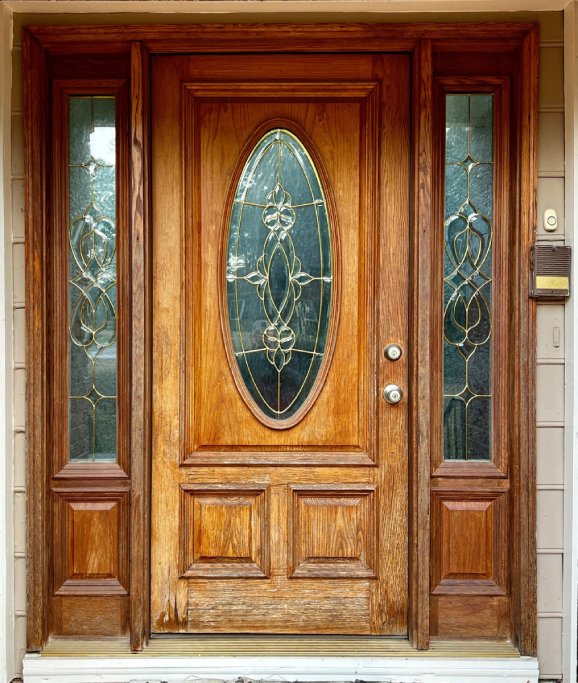Title: Maximizing Durability and Aesthetics: The Art of Door Refinishing
Do you find yourself frustrated by the gradual fading and wear of your wooden doors? In this enlightening piece, we delve deep into the nuances of selecting the perfect wood type for door refinishing endeavors, elevating both the visual allure and the lifespan of your doors.
Embark with us on a journey through the pivotal techniques and materials capable of metamorphosing a mundane door into a testament of exquisite craftsmanship.
Together, we’ll unravel the intricacies of door refinishing, ensuring your doors not only endure the test of time but also withstand the elements gracefully. Presented in collaboration with Door4life, a leading door refinishing company, let’s delve into these transformative techniques and breathe new life into your living space.
Mastering the Essentials of Door Refinishing
Door refinishing breathes new life into weathered or aged wooden doors, restoring both their aesthetic charm and structural integrity. Typically encompassing the removal of old finishes, meticulous sanding of the bare wood, rectifying imperfections, and culminating in the application of fresh stain or paint followed by a protective sealant.
The significance of selecting the appropriate wood type cannot be overstated in door refinishing projects. Different wood species exhibit distinct durability, grain patterns, and hues, influencing the final outcome significantly. Acquiring a grasp of these factors alongside adept techniques like sanding and staining ensures a triumphant and rejuvenating door refinishing endeavor.
Dive into the World of Wood Types in Door Refinishing
The choice of wood type stands as a linchpin in indoor refinishing ventures, directly impacting both durability and aesthetics. Varied wood species boast unique densities, grain patterns, and inherent colors, exerting profound effects on the ultimate appearance and resilience of the door against external elements.
Understanding the Interplay of Wood Type, Durability, and Aesthetics
Each wood variety offers a distinct blend of durability and visual allure post-refinishing. For instance, robust hardwoods such as oak and mahogany exhibit heightened resistance to wear and tear, rendering them ideal for high-traffic zones and external door installations. Moreover, these woods possess an innate propensity to absorb stains and finishes, resulting in richer and more vibrant hues that amplify the door’s visual appeal.
Top Wood Choices for Doors
- Mahogany: Renowned for its exceptional durability and moisture resistance, making it an impeccable choice for external doors in humid climates.
- Oak: Boasting unparalleled robustness and striking grain patterns, oak stands as an ideal candidate for doors subjected to heavy usage.
- Cherry: Esteemed for its deep, lustrous tones and velvety grain, cherry wood reigns supreme in interior doors where aesthetics reign supreme.
- Alder: While marginally softer than its hardwood counterparts, alder presents a cost-effective solution that readily absorbs stains, making it suitable for internal doors and budget-conscious projects.
Delving Deeper into Wood Varieties
An in-depth understanding of various wood species aids in pinpointing the optimal material for door refinishing initiatives, aligning durability requisites with aesthetic preferences seamlessly.
Exploring Key Wood Characteristics
The grain patterns and hues of different wood types vary significantly, exerting a profound influence on the final aesthetic. For instance, maple boasts a subdued, uniform grain ideal for contemporary settings, while oak exudes a robust, pronounced grain suited for traditional décors.
Assessing Hardness and Moisture Resistance
The hardness of wood dictates its susceptibility to scratches and indentations. Hardwoods like hickory and oak emerge as stalwarts, excelling in high-traffic environments. Furthermore, moisture resistance assumes paramount importance, especially in exterior door applications, with teak and mahogany standing out for their imperviousness to moisture-induced warping and swelling.
Engineered vs. Solid Wood: Deciphering the Differences
Engineered wood, comprising wood veneers or fibers bonded with adhesives, offers a uniform appearance and cost savings. In contrast, solid wood, hewn directly from trees, embodies natural charm and uniqueness. While engineered wood thrives in fluctuating climates, solid wood permits multiple refinishing cycles, albeit necessitating more extensive maintenance.
Navigating Wood Characteristics in Refinishing Endeavors
The success of a door refinishing venture hinges on a nuanced comprehension of the wood’s intrinsic traits. The judicious selection of wood type, predicated on hardness and moisture resistance, holds the key to augmenting both durability and visual allure.
Picking Wood Based on Hardness
The hardness of wood emerges as a pivotal factor in door refinishing projects. Hardwoods like oak and mahogany, revered for their resilience, emerge as frontrunners, ideal for high-traffic locales. Conversely, softer woods like pine, while easier to work with, demand heightened maintenance.
Considering Moisture Content
The moisture content of wood dictates its expansion and contraction tendencies, exerting a pronounced influence on the refinishing process and subsequent longevity. Teak and cedar, famed for their moisture resistance, emerge as superlative choices for exterior door refinishing, safeguarding against the vagaries of the elements.
Embark on a Step-by-Step Journey to Door Refinishing Excellence
Achieving a flawless finish in door refinishing mandates meticulous attention to detail at every juncture. Follow this systematic guide to breathe new life into your weathered or timeworn doors:
- Surface Preparation: Commence by meticulously cleaning the door surface and stripping away old finishes using a chemical stripper or sanding.
- Stain Application: Select an appropriate stain to accentuate the wood’s natural beauty, ensuring even application and sufficient penetration.
- Sealing and Finishing: Conclude the process by applying a sealant to fortify the wood against moisture and wear, opting for polyurethane, varnish, or lacquer based on usage and aesthetic preferences.
Unlocking the Art and Science of Staining Wooden Doors
Staining represents a delicate interplay of artistry and scientific precision, enhancing the wood’s innate allure while infusing it with character and color.
Navigate the Spectrum of Wood Stains
Different wood stains offer distinct advantages and drawbacks, catering to diverse refinishing requirements:
- Acid Stain: Renders a transparent, rustic aesthetic, accentuating the wood’s natural grain.
- Water-Based Stain: Boasts rapid drying and easy cleanup, albeit potentially raising the wood grain.
- Oil-Based Stain: Yields deeper hues and heightened durability, albeit entailing longer drying times and a pungent odor.
- Gel Stain: Ideal for highlighting grain patterns and minimizing blotching, albeit potentially necessitating multiple coats.
Crafting a Professional Finish
Achieving a professional-grade finish necessitates precision and finesse. Apply the stain evenly in the direction of the grain, working methodically to maintain a wet edge and ensure uniform coverage.
Deciphering the Ideal Finish for Your Door
The final finish on your door not only safeguards the wood but also profoundly influences its color and grain presentation. Familiarize yourself with the various finishes available and their applications to make an informed decision aligned with your preferences and usage requirements.
Navigating Longevity and Maintenance Imperatives
The durability of the finish hinges on meticulous application and regular upkeep. Regular cleaning and periodic touch-ups serve as bulwarks against premature wear and deterioration, preserving the door’s allure and structural integrity for years to come.
Unraveling the Role of Sealants in Door Refinishing
Sealants emerge as indispensable guardians in the door refinishing process, fortifying the wood against environmental vicissitudes and
preserving its structural integrity and aesthetics.
Illuminate Your Path to Door Refinishing Excellence
Armed with these insights and techniques, you possess the wherewithal to embark on a transformative door refinishing journey. For those craving further guidance or seeking to delve deeper into the realm of door refinishing, Door4Life stands as your trusted ally, offering a treasure trove of resources and expert insights tailored to elevate your home improvement endeavors. Join the conversation in the comments section or peruse our blog to continue enriching your home’s ambiance and functionality.
FAQ:
What wood types are recommended for Door Refinishing Projects?
Teak, Oak, Cherry, Maple, and Mahogany are exceptional choices, lauded for their durability, aesthetic appeal, and suitability for refinishing ventures.
How does the choice of wood surface affect commercial projects?
The surface type wields a profound influence on durability, aesthetics, and budget considerations. Options like hardwood veneers, MDF, and HPDL surfaces cater to a spectrum of project exigencies.
Which wood surfaces work best for high-traffic areas in healthcare facilities?
High-impact or HPDL surfaces emerge as the preferred choice, offering resilience, ease of maintenance, and resistance to heavy traffic and equipment-induced damage.
What are the advantages of using wood veneers in office projects?
Wood veneers exude sophistication, especially for stile and rail doors, striking a harmonious balance between aesthetics and durability in office settings.
What is the primary consideration when selecting wood for refinishing furniture?
Opt for hardwoods like poplar or soft maple, renowned for their smooth finish, paintability, and durability against warping.
Which wood is highly resistant to decay, making it suitable for outdoor projects?
Cedar stands as a paragon of decay resistance, making it an apt choice for outdoor installations like doors, fencing, and posts.
Why are hardwoods preferred for interior doors in construction projects?
Hardwoods like oak and walnut epitomize strength, durability, and aesthetic appeal, rendering them ideal for interior door applications in construction ventures.
How does the choice of wood surface impact the longevity of doors in educational settings?
Durable options like paintable MDO or laminates uphold resilience, longevity, and safety in educational environments, withstanding the rigors of daily use and promoting a conducive learning atmosphere.
Sources:
Rustica, Degmeda, Octane Seating, Ekomia, Dragonfire Tools, Masonite Architectural


